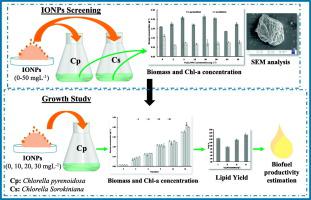Algal Research ( IF 5.1 ) Pub Date : 2020-05-21 , DOI: 10.1016/j.algal.2020.101942 Mohit Singh Rana , Shashi Bhushan , D. Ruben Sudhakar , Sanjeev Kumar Prajapati

|
Effect of iron oxide (α-Fe2O3) nanoparticles (IONPs) on microalgal growth and biofuel productivity was tested in BG11 media. IONPs supplementation produced a contradicting effect between the two species, namely, Chlorella pyrenoidosa and Chlorella sorokiniana. IONPs at 20 mg·L−1 showed up to 33.75% enhancement in biomass concentration during 15 d cultivation of C. pyrenoidosa. Conversely, the IONPs, even at a low dose of 2 mg·L−1, showed toxicity to C. sorokiniana. The highest biomass production of 2.16 g·L−1 (lipid content of 13.77 wt%) was observed at IONPs 20 mg·L−1, while 30 mg·L−1 resulted in highest lipid accumulation of 16.89 wt% (biomass concentration of 2.01 g·L−1) in C. pyrenoidosa. The variation in biomass concentration and lipid accumulation follows closely the chlorophyll-a profile, indicating the effective response to the IONPs. Scanning electron microscope images revealed nanoparticle agglomeration on the surface of C. pyrenoidosa beyond 20 mg·ed. C. pyrenoidosa was found promising for biofuel production with biofuel productivity of 20.62 TOE·ha−1·y−1 at IONPs concentration of 30 mg·L−1. Current findings reveal the feasibility of IONPs supplementation in the microalgal media to improve the growth as well as lipid content. In nutshell, the results put forward a stepping stone for the sustainable biofuel recovery from microalgal biomass in near future.
中文翻译:

氧化铁纳米颗粒对小球藻生长和生物燃料潜力的影响。
氧化铁的效果(的α-Fe 2 ö 3上微藻生长和生物燃料生产率)纳米颗粒(IONPs)在BG11培养基中进行测试。IONPs的补充在两个物种(即小球藻小球藻和小球藻小球藻)之间产生了矛盾的作用。在20个月的培养过程中,C。pyrenoidosa的IONPs在20 mg·L -1下的生物量浓度提高了33.75%。相反,即使在2 mg·L -1的低剂量下,IONPs也对C. sorokiniana表现出毒性。在IONPs 20 mg·L -1下观察到最高的生物量产量为2.16 g·L -1(脂质含量为13.77 wt%)。,而30毫克·L -1导致的16.89重量%(将2.01g·L生物量浓度最高脂质积聚-1中)小球藻。生物量浓度和脂质积累的变化紧密遵循叶绿素-a曲线,表明对IONP的有效响应。扫描电子显微镜图像显示,超过20 mg·ed的梭状芽孢杆菌表面纳米颗粒附聚。小球藻发现与20.62 TOE的生物燃料生产率有望用于生物燃料的生产·公顷-1 ·Y -1以30mg IONPs浓度·L -1。当前的发现揭示了在微藻培养基中补充IONPs改善生长和脂质含量的可行性。简而言之,结果为在不久的将来从微藻生物质中可持续回收生物燃料提供了垫脚石。


























 京公网安备 11010802027423号
京公网安备 11010802027423号